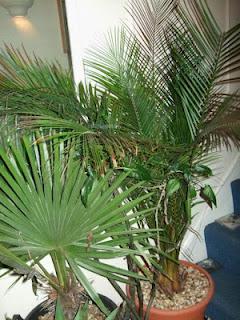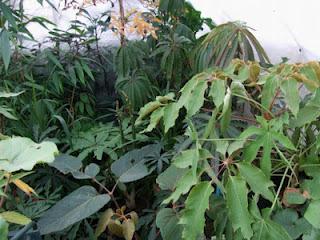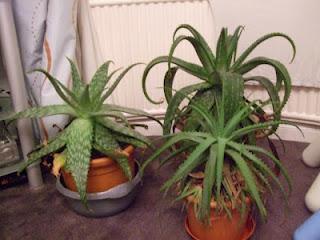Like many exotic gardening enthusiasts one of the challenges we face is how best to overwinter plants indoors. We all think about the cold being a problem but adequate heat is just one aspect. If we neglect some of the other aspects then the plants may survive indoors or in the greenhouse but will look pretty poor by the spring. While tropical plants far from the equator are outside of their natural climate, with a little effort we can ensure the growth and health of our plants overwintered indoors or in the greenhouse. Here are our thoughts on the considerations to maintain a suitable environment for such plants overwintered indoors.
Adequate Light  While tropical plants live in climates that experience direct sunlight year round, many of these plants thrive in the shade of larger trees or are shielded from the harsh sun by the heavy rainforest canopy. Therefore, the shade of the indoors can actually be an ideal environment for them to flourish. For best results, consider the light levels needed for each plant and if appropriate place plants in a room where it will receive plenty of light but avoid putting it in the path of direct, intense sunlight as this may be harmful to the leaves. We overwinter some plants in a large insulated outbuilding, so only a small amount of heat is needed but light levels are low. We tend to place ferns and palms tolerant of low light levels in here, but add an low wattage grow light on a timer to come on and give the plants a boost.
While tropical plants live in climates that experience direct sunlight year round, many of these plants thrive in the shade of larger trees or are shielded from the harsh sun by the heavy rainforest canopy. Therefore, the shade of the indoors can actually be an ideal environment for them to flourish. For best results, consider the light levels needed for each plant and if appropriate place plants in a room where it will receive plenty of light but avoid putting it in the path of direct, intense sunlight as this may be harmful to the leaves. We overwinter some plants in a large insulated outbuilding, so only a small amount of heat is needed but light levels are low. We tend to place ferns and palms tolerant of low light levels in here, but add an low wattage grow light on a timer to come on and give the plants a boost.
When putting plants back outside again after winter remember they have had lower light levels, and place them in a shady location initially to acclimatise with the higher light levels experienced. We use the side passage next to the kitchen as it is north facing, after a few days to a week in this spot we know that the overwintered plants will be safe to move to their final summer homes. Healthy Soil
Healthy Soil
Exotic plants are accustomed to the fertile earth of tropical climates so choose high quality soil for potted specimens, and consider the right type of compost. We tend to use a general multi purpose compost for most plants, but will adapt this as needed. Occasionally adding a weak fertilizer to your plant will keep it healthy and growing, but keep in mind the light levels, as too much feeding leads to weak leggy growth. Often it can be better to wait until spring and start the feeding regime as plants go back outside. While many plants from the tropics can grow to be quite large, many will still flourish in a smaller pot. Transplant them to larger pots when necessary, but remember to select pots that do not have too much excess space. Keeping pot sizes down also helps when moving them about, having too large a pot can literally be a pain in the back!
Warm Temperatures  One of the most important factors in maintaining healthy tropical plants over winter is temperature. Climates near the equator are warm year round and exotic plants require this same constant warmth indoors or a minimum overnight temperature in order to thrive. Electric radiators offer a convenient way to create this type of environment, and with thermostatic controls you can ensure the heater keeps the greenhouses at the correct temperature, and not too much above (and certainly not below!). We use an electric heater in each greenhouse and in the outbuilding keeping temperatures in there generally above 5C (41f). The more tender plants are kept in the house, usually at a temperature above 16 degrees Celsius (60f). With the greenhouses it is important to have a backup in the case of a power cut, and we have paraffin burners available should the need arise.
One of the most important factors in maintaining healthy tropical plants over winter is temperature. Climates near the equator are warm year round and exotic plants require this same constant warmth indoors or a minimum overnight temperature in order to thrive. Electric radiators offer a convenient way to create this type of environment, and with thermostatic controls you can ensure the heater keeps the greenhouses at the correct temperature, and not too much above (and certainly not below!). We use an electric heater in each greenhouse and in the outbuilding keeping temperatures in there generally above 5C (41f). The more tender plants are kept in the house, usually at a temperature above 16 degrees Celsius (60f). With the greenhouses it is important to have a backup in the case of a power cut, and we have paraffin burners available should the need arise.
We also insulate the greenhouses with bubble wrap, to trap that heat inside, the outbuilding we have was already insulated so that helps keep the heat in and the electricity bill down!
Proper Watering
It is easy to make the mistake of giving their plants too much or too little water. While tropical plants require regular watering, they also need time to dry out naturally or their roots will begin to rot. Ensure your plant is in a pot that has adequate holes for drainage. The water regime needs to be adjusted for each plant (and location). Those in the greenhouses/outbuilding are kept at a lower temperature and need less water, the last thing you need is for them to be sat in cold/cool damp soil for any length of time. We let these get quite dry and then water very sparingly. The plants in the house need a different regime, with centrally heated houses the air will be very dry and as it is warm the plants will usually stay in active growth and need more water. In particular some palms we water a couple of times a week.
We also have a number of arid plants and those in the greenhouses are not watered all winter, only starting to water again when the weather improves, the arid plants in the house are watered but far more sparingly than the lush plants.
Correct Humidity Tropical climates often include a significant amount of humidity and the drier conditions of the house are not ideal. If you have plants in a heated conservatory then you could replicate this moisture by adding a humidifier. In the main house plants will have to cope with the conditions of the home, but choose a location for plants where there is naturally more moisture such as the kitchen or bathroom. We keep several plants in the hallway as it doesn't get as warm/dry and when the front door is opened damper winter air will come in. We tend to place some aloes and agaves into the lounge, where they really seem to enjoy the warm dry air, so much so that some of them look better in the house than they do outside in the garden!
Tropical climates often include a significant amount of humidity and the drier conditions of the house are not ideal. If you have plants in a heated conservatory then you could replicate this moisture by adding a humidifier. In the main house plants will have to cope with the conditions of the home, but choose a location for plants where there is naturally more moisture such as the kitchen or bathroom. We keep several plants in the hallway as it doesn't get as warm/dry and when the front door is opened damper winter air will come in. We tend to place some aloes and agaves into the lounge, where they really seem to enjoy the warm dry air, so much so that some of them look better in the house than they do outside in the garden!
The opposite problem exists with the greenhouses, with it being cooler you don't want high humidity, we use electric heaters partly for the dry air they give, and also open the doors on warm sunny days to get fresh air and a breeze into them. In the outbuilding we had found that if the doors were kept closed for too long then you could get some mold forming with the damp cool air, but with regular fresh air and a fan blowing this is much less of a problem than it once was.
This winter the weather has mostly been quite kind to us, so we haven't had to use too much electricity to keep the greenhouses at a suitable minimum temperature, and so far everything is looking fine. Some plants that were in for the very cold spell have even started to go back outside.
Not long now until Spring!
Gaz

